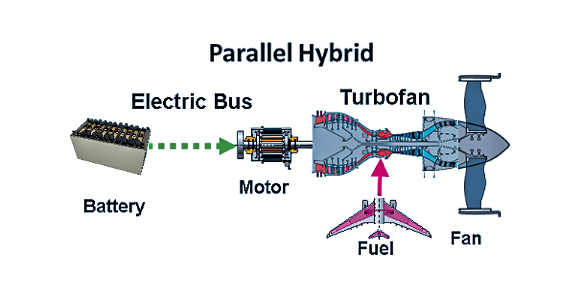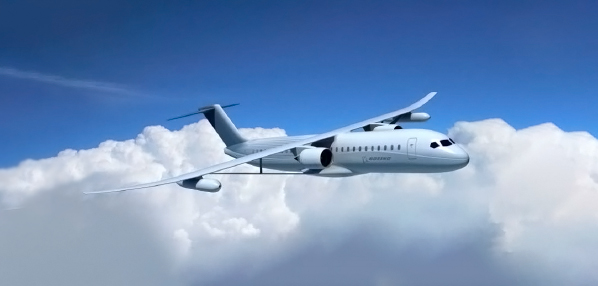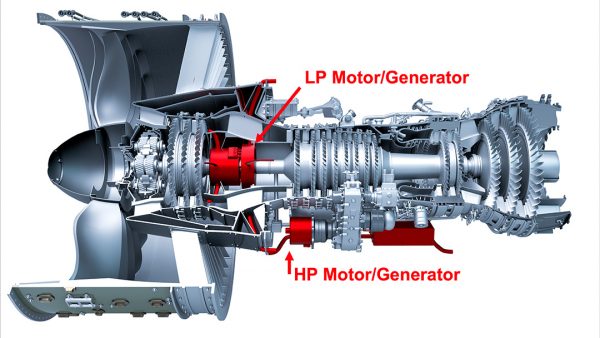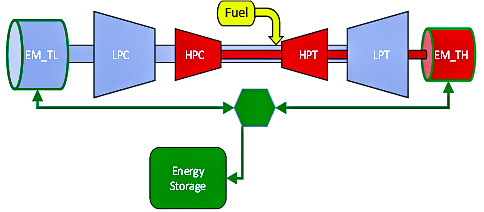Turbine Electrified Energy Management (TEEM)
Turbine Electrified Energy Management (TEEM) is a new Electrified Aircraft Propulsion (EAP) technology designed to enhance performance and efficiency of hybrid-electric aircraft. Aiming to reduce fuel burn, hybrid powertrains feature traditional gas turbine engines and integrated electric machines, including motors and generators, that supply additional thrust or extract power to drive strategically placed propulsors. To effectively manage energy across hybrid systems, the TEEM concept offers innovative solutions to improve engine operations and safety in aircraft with highly complex and tightly integrated propulsion systems.
The need for control technology
While hybrid powertrains offer unique benefits to aircraft systems, there are key challenges that must be addressed to ensure effective operations. The primary issues stem from inherent inefficiencies associated with electrical powertrains which often lead to wide variations in turbo-machinery operations due to varying levels of power extraction, injection, or transfer between the engine spools. As air flows through a gas turbine engine’s compressor and turbine, it imparts a force on the shaft which connects these components together. Adding or extracting electrical power can impact the shaft speed and influence the air flow through the engine, which alters the engine’s operation.
While electrical power systems pose challenges to turbo-machinery operability, they can also be used to improve it. In order to realize the viability of hybrid powertrains, control approaches are needed to help extract the most out of the aircraft’s electrical power system.

TEEM is a control technology to help manage energy more effectively in EAP systems and improve turbo-machinery performance. TEEM takes advantage of the electrical power system integrated with turbo-machinery, which includes electric machines and energy storage that can supply and absorb power as needed. The ultimate goal of the TEEM concept is to enable higher performance and operability in propulsion systems with lightweight components that can strengthen the overall capabilities of a hybrid-electric aircraft.
Improving operability though TEEM
The major effort of TEEM researchers to date has been to improve transient operability of turbo-machinery. During transients, or changes to an engine’s normal steady operations, the system’s natural response temporarily shifts the engine components away from their steady state condition, or equilibrium. As steady state conditions are altered, disruptions in air flow and speed within the engine’s compressor can cause off-incidence flow impinging on the compressor blades, which can result in stall or surge conditions.
To avoid these conditions, a sufficient and often conservative amount of stall margin is kept to account for differences in engine operation. This compromise ends up limiting the engine’s design opportunities and impacts overall performance. To minimize issues that may hinder safe, stable, and efficient engine performance during flight, TEEM provides new ways to utilize electric machines to benefit turbo-machinery performance by modifying the engine’s dynamic response.
The unique TEEM transient operability concept uses electric machines in hybrid powertrains to help provide power to, or extract power from, an engine’s shaft that allow the engine’s operations to be altered during transients. Electric machines are used as new engine actuators, which can be used to manage the energy in the engine system, and energy storage is present to supply or absorb energy as needed. When changes occur in engine power levels, these actuators will help reduce disruptions to steady state conditions and prevent the engine from approaching stall or surge conditions.
The TEEM concept could also be expanded beyond transient operability to include various other uses of the electric powertrain in order to manage system operability. With the goal of benefiting the overall aircraft system, TEEM can be applied to other cases such as power extraction, injection, or transfer to perform or supplement the use of stability bleeds, as well as general transient optimization such as increasing thrust or thrust responsiveness, and the expansion of the systems operating envelope.
Advancing the future of flight
Control technologies for hybrid powertrains will play a critical role in improving engine performance for future electrified aircraft by managing energy more effectively. The TEEM concept enables a new way to augment power of an engine’s shafts in order to reduce the need for performance-restricting margins that will enable lighter and more efficient propulsion systems.

Future electrified aircraft will require lightweight systems and components in order to maximize performance and safety. By improving transient operability, TEEM can open up several new engine design possibilities that can ultimately strengthen thermal and propulsive efficiency, as well as help minimize system weight and improve fuel efficiency. Reducing overall weight of propulsion systems and onboard fuel storage could also help extend the aircraft’s range and potentially increase its capacity for passengers or cargo.
The TEEM concept will undergo testing at the NASA Electric Aircraft Testbed (NEAT) facility under the Hybrid Thermally Efficient Core (HyTEC) project, which seeks to increase fuel efficiency by developing small core turbofan engine technologies. As the aviation industry moves toward a future with sustainable flight, the TEEM benefits and improvements to hybrid aircraft will ensure safer and more reliable operations.
Related Publications
| Title | Authors | Date |
|---|---|---|
| "Failure Modes and Mitigation Strategies for a Turboelectric Aircraft Concept with Turbine Electrified Energy Management" | Kratz and Simon | 26 November, 2021 |
| "Exploration of the Versatile Electrically Augmented Turbine Engine Gearbox Concept" | Culley and Kratz | 07 July, 2021 |
| "Enhancement of an Electrified Tilt-Wing Propulsion System using Turbine Electrified Energy Management" | Culley and Kratz | 01 December, 2020 |
| "A Control Strategy for Turbine Electrified Energy Management" | Kratz et al. | 01 October, 2019 |
| "Evaluation of Electrical System Requirements for Implementing Turbine Electrified Energy Management" | Kratz et al. | 04 September, 2019 |
| "Turbine Electrified Energy Management (TEEM) For Enabling More Efficient Engine Designs" | Culley et al. | 25 April, 2019 |


